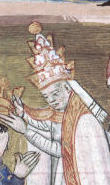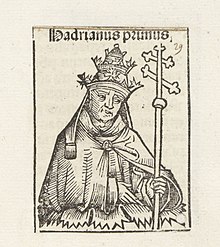
Charlemagne was King of the Franks from 768, King of the Lombards from 774, and Emperor of the Carolingian Empire from 800, all until his death in 814. Charlemagne succeeded in uniting the majority of Western Central Europe, and he was the first recognized emperor to rule in the west after the fall of the Western Roman Empire approximately three centuries earlier. Charlemagne's rule saw a program of political and social changes that had a lasting impact on Europe in the Middle Ages.
Pope Stephen II was born a Roman aristocrat and member of the Orsini family. Stephen was the bishop of Rome from 26 March 752 to his death. Stephen II marks the historical delineation between the Byzantine Papacy and the Frankish Papacy. During Stephen's pontificate, Rome was facing invasion by the Lombards when Stephen II went to Paris to seek assistance from Pepin the Short. Pepin defeated the Lombards and made a gift of land to the pope, eventually leading to the establishment of the Papal States.
Pope Stephen III (or iv) (Latin: Stephanus III; 720 – 24 January 772) was the bishop of Rome and ruler of the Papal States from 7 August 768 to his death. Stephen was a Benedictine monk who worked in the Lateran Palace during the reign of Pope Zachary. In the midst of a tumultuous contest by rival factions to name a successor to Pope Paul I, Stephen was elected with the support of the Roman officials. He summoned the Lateran Council of 769, which sought to limit the influence of the nobles in papal elections. The Council also opposed iconoclasm.
The 770s decade ran from January 1, 770, to December 31, 779.
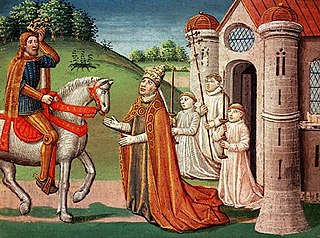
Year 772 (DCCLXXII) was a leap year starting on Wednesday of the Julian calendar. The denomination 772 for this year has been used since the early medieval period, when the Anno Domini calendar era became the prevalent method in Europe for naming years.

The year 771 (DCCLXXI) was a common year starting on Tuesday of the Julian calendar. The denomination 771 for this year has been used since the early medieval period, when the Anno Domini calendar era became the prevalent method in Europe for naming years.

Carloman I, also Karlmann, was king of the Franks from 768 until he died in 771. He was the second surviving son of Pepin the Short and Bertrada of Laon and was a younger brother of Charlemagne. His death allowed Charlemagne to take all of Francia and begin his expansion into other kingdoms.

Desiderius, also known as Daufer or Dauferius, was king of the Lombards in northern Italy, ruling from 756 to 774. The Frankish king of renown, Charlemagne, married Desiderius's daughter and subsequently conquered his realm. Desiderius is remembered for this connection to Charlemagne and for being the last Lombard ruler to exercise regional kingship.

The siege or battle of Pavia was fought in 773–774 in northern Italy, near Ticinum, and resulted in the victory of the Franks under Charlemagne against the Lombards under King Desiderius.

Aistulf was the Duke of Friuli from 744, King of the Lombards from 749, and Duke of Spoleto from 751. His reign was characterized by ruthless and ambitious efforts to conquer Roman territory to the extent that in the Liber Pontificalis, he is described as a "shameless" Lombard given to "pernicious savagery" and cruelty.

Pepin or Pippin was King of Italy from 781 until his death in 810. Born Carloman, he was the third son of Charlemagne. Carloman was renamed Pepin upon his baptism in 781, where he was also crowned as king of the Lombard Kingdom his father had conquered. Pepin ruled the kingdom from a young age under Charlemagne, but predeceased his father. His son Bernard was named king of Italy after him, and his descendants were the longest-surviving direct male line of the Carolingian dynasty.

Hildegard was a Frankish queen and the wife of Charlemagne from c. 771 until her death. Hildegard was a noblewoman of Frankish and Alemannian heritage. Through eleven years of marriage with Charlemagne, Hildegard helped share in his rule as well as having nine children with him, including the kings Charles the Younger and Pepin of Italy and the emperor Louis the Pious.

Pepin the Short, was King of the Franks from 751 until his death in 768. He was the first Carolingian to become king.
Desiderata was a queen consort of the Franks. She was one of four daughters of Desiderius, King of the Lombards, and his wife Ansa, Queen of the Lombards. Desiderata was married to Charlemagne in 770 in effort to create a bond between Francia and the Kingdom of the Lombards. The marriage also sought to isolate Charlemagne's brother Carloman I, who ruled over the central territories of Francia. It lasted just one year, and there are no known children.
The Patrimony of Saint Peter originally designated the landed possessions and revenues of various kinds that belonged to the apostolic Holy See. Until the middle of the 8th century this consisted wholly of private property; later, it corresponded to the territories under Papal sovereignty, but from the early 13th century the term was applied to one of the four provinces of the States of the Church.
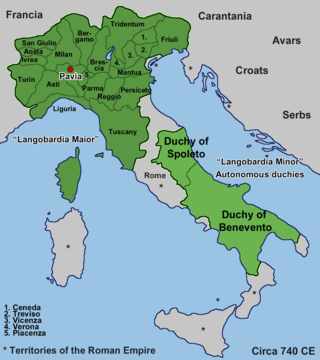
The Kingdom of the Lombards, also known as the Lombard Kingdom and later as the Kingdom of all Italy, was an early medieval state established by the Lombards, a Germanic people, on the Italian Peninsula in the latter part of the 6th century. The king was traditionally elected by the very highest-ranking aristocrats, the dukes, as several attempts to establish a hereditary dynasty failed. The kingdom was subdivided into a varying number of duchies, ruled by semi-autonomous dukes, which were in turn subdivided into gastaldates at the municipal level. The capital of the kingdom and the center of its political life was Pavia in the modern northern Italian region of Lombardy.
Gerberga was the wife of Carloman I, King of the Franks, and sister-in-law of Charlemagne. Her flight to the Lombard kingdom of Desiderius following Carloman's death precipitated the last Franco-Lombard war, and the end of the independent kingdom of the Lombards in 774.

Adelperga was a Lombard noblewoman, Duchess of Benevento by marriage to Arechis II of Benevento. She acted as regent of Benevento for her son Grimoald in 787-788. She was the third of four daughters of Desiderius, King of the Lombards, and his wife Ansa. Her elder sister Desiderata was a wife of Charlemagne.
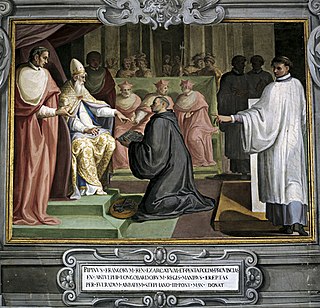
From 756 to 857, the papacy shifted from the influence of the Byzantine Empire to that of the kings of the Franks. Pepin the Short, Charlemagne, and Louis the Pious had considerable influence in the selection and administration of popes. The "Donation of Pepin" (756) ratified a new period of papal rule in central Italy, which became known as the Papal States.
Autchar was a Frankish nobleman. He served Pippin III as a diplomat in 753 and followed Carloman I after the division of the kingdom in 768. In 772, refusing to accept Carloman's brother Charlemagne as king, he went into exile in the Lombard kingdom with Carloman's widow and sons. He was captured when Charlemagne invaded the kingdom in 773. His role in the fall of the Lombard kingdom was the subject of legendary embellishment a century later and in the chansons de geste he evolved into the figure of Ogier the Dane.
